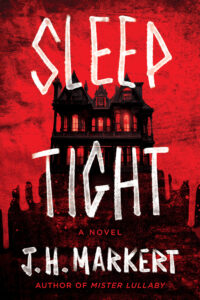All books, at least in part, are inspired by something or someone, if not entirely conjured by the inspiration of creativity alone, and my latest novel, Sleep Tight, is no different, even if that inspiration comes as a deeply rooted, convoluted bundle of fact, fiction, and misconception over the controversial mental disorder once known as Multiple Personality Disorder (MPD), now referred to as Dissociative Identity Disorder (DID).
Dissociative Identity Disorder has been portrayed countless times in movies and books and on TV over the decades, so in tackling the concept in Sleep Tight, I was very cognizant to fact that if I was going to do it, I wanted to accomplish two things—one, make the use of it unique, and two, treat the topic of mental illness in a respectful way.
Witnessing a few movies too early in my childhood—namely The Exorcist, Sybil, and Psycho—paved the way for some deeply rooted fears of mine. Today, at fifty, I’m still terrified of the concept of “possession” and although DID no longer scares me as it did as a boy, I’m still fascinated by it, not only the disorder itself but the history of its rise and fall in the public eye. And ever since Psycho, I’ve never looked at a shower curtain the same way; in fact, the mere sound of a shower curtain opening still gives me the shivers.
But watching and then reading Sybil, along with The Three Faces of Eve and The Minds of Billy Milligan, set me on a course of fascination I knew would not be sated until I wrote something of my own on the topic. Rotten Tomatoes aside, I thoroughly enjoyed The Crowded Room, the Apple TV+ show, where Tom Holland did an amazing job portraying Milligan’s many characters. But let’s just say that the idea for Sleep Tight had been brewing for a while before it came to fruition, and in hindsight, seeing David Banner change into the Hulk on the late 1970s and early 80s TV Show The Incredible Hulk, had more influence on me than I’d initially thought, and the true-crime story of Billy Milligan soon followed.
Like the novella The Strange Case of Dr. Jekyll and Mr. Hyde did during in its time with the concept of the “splitting of the mind”—one I touch heavily upon in my novel The Strange Case of Isaac Crawley—the case of Billy Milligan brought to the public eye not only Multiple Personality Disorder, but the sensationalism of it that swept the nation in the decade or more that followed. During his trial for kidnapping, robbing and raping several women near the Ohio State University campus, a psychiatrist testified under oath that Milligan not only had 24 personalities, but one of them was guilty of the crimes, and he became the first person in the United States to be found not guilty by reason of insanity for crimes committed while suffering from DID. Aside from the fictional story of Jekyll and Hyde, the other three above mentioned cases—although much of Sybil has now been debunked—all follow the pattern of childhood abuse as the cause for MPD. This theory led to the whirlwind of increased diagnoses that swept through the country in the 1980s, taking a disorder that was once considered extremely rare to more than 40,000 cases diagnosed by the end of that decade. It was portrayed in books, in movies, and all over the talk-show circuit. Serial killer Kenneth Bianchi, also known as The Hillside Strangler, attempted to use multiple personalities in his defense, to no avail, but it was another example of the sensationalism of the time. While The American Psychiatric Association officially recognized MPD in 1980, it was renamed DID is 1994, and with that came clearer guidelines, much less diagnosis, and therefore, over time, a decrease in attention. But it never left this author’s imagination, and my intrigue, over the years, was enhanced by other movies and books I feel must be mentioned whenever DID is brought to the forefront—or at least my forefront.
Seeing Ed Norton in the movie Primal Fear will forever be etched in my brain. Although a fictional thriller, it’s not a stretch to see that this story was inspired by the real Billy Milligan, as was—I assume—M. Night Shyamalan’s movie Split, which hits all the DID tropes and perhaps takes the sensationalism of the disorder to the max, but I still enjoyed the hell out of it, and James McAvoy knocks Kevin’s 23 personalities out of the park. Secret Window, starring Johnny Depp, is also one of my all-time favorites, with a twist that left an indelible mark on my creative soul, not to mention that it was based on the story, Secret Window, Secret Garden by my literary hero Stephen King.
We can’t touch upon the topic of DID without mentioning the movie Identity, starring John Cusack, and the Hitchcockian ending that punctuates that movie—it still shakes me—I only wish the twist could happen anew each time I watched it. Like with Secret Window, I’d read Dennis Lehane’s amazing novel, Shutter Island, before I saw the movie, starring Leonardo DiCaprio and Mark Ruffalo, but the twist still got me! And still gets me. This story—with both the book and the movie—is so eerie and macabre that the hospital and island becomes characters in and of themselves, and the time period, for me, is icing on an already tasty cake.
At the risk of talking about Fight Club—because we all know the rules about Fight Club—both the book by Chuck Palahniuk and the movie starring Brad Pitt and Ed Norton, I feel as if I must not only mention it but mention it last—and with haste!—so I can make a quick escape for talking about it in the first place, but here it goes. I must say I watched this movie years before I read the book, but with both I sat there wondering WTF just happened, and even though I’d seen the movie, WTF did I just read? Either way, as far as entertainment is concerned, and with DID specifically, this story is a must, and almost too deep to explain without giving it all away, so with that being said, and because I am a rule follower, I will now ease out without fully talking about Fight Club.
***


















